Material Flow Analysis-Based Sustainability Assessment for Circular Economy Scenarios of Urban Building Stock of Vienna
Abstract
1. Introduction
2. Materials and Methods
2.1. An Updated Model for Material Flows, Heating Energy Demand, and Greenhouse Gas Emissions of Vienna’s Building Stock
2.1.1. Definition of a Development Pathway for Vienna’s Building Stock 2021–2050
2.1.2. Updated Material Input and Output Model by New Data
2.1.3. Modelling the Material Input and Output of the Updated Building Model of Vienna
2.1.4. Modelling the Heating Energy Demand of the Updated Building Model of Vienna
2.1.5. Modelling the Greenhouse Gas Emissions of the Updated Building Model of Vienna
2.2. Modelling the Material Flows of Construction Materials and Demolition Waste of the Updated Building Model of Vienna Considering Non- and Enhanced Circular Economy Scenarios
2.2.1. Material Flows of Construction Materials and Demolition Waste without Local Circular Economy in the Building Sector
2.2.2. Material Flows of Construction Materials and Demolition Waste with Local Circular Economy in the Building Sector
2.3. Assessing the Scenarios without vs. with a Local Circular Economy of the Updated Building Model
2.3.1. Heating Energy Demand (HED)
2.3.2. Direct Greenhouse Gas Emissions from Heating
2.3.3. Total Material Requirement
2.3.4. Circular Material Use Rate
3. Results and Discussion
3.1. Updated Material Inputs and Outputs, Heating Energy Demand, and Greenhouse Gases of Vienna’s Building Sector
3.2. Material Flows of Construction Materials and Demolition Wastes of the Updated Building Model of Vienna with and witout Enhanced Circular Economy Scenarios
3.3. Assessing the Updated Building Model
3.3.1. Heating Energy Demand and Greenhouse Gas Emissions
3.3.2. Total Material Requirement and Circular Material Use Rate with a Local Circular Economy Scenario
4. Conclusions
Supplementary Materials
Author Contributions
Funding
Institutional Review Board Statement
Informed Consent Statement
Data Availability Statement
Conflicts of Interest
Appendix A
| Material | Building Age and Renovation Category | MICinput | MICoutput | MICinput | MICoutput | MICinput | MICoutput | MICinput | MICoutput |
|---|---|---|---|---|---|---|---|---|---|
| Residential Buildings | Service Buildings | Industrial Buildings | Other Buildings | ||||||
| Concrete | 1800–1918 | - | 250.6 | - | 183.0 | - | 917.5 | - | 81.4 |
| 1800–1918 Renovated | - | - | - | - | - | - | - | - | |
| 1800–1918 Attic extension | 920.3 | - | - | - | - | - | - | - | |
| 1919–1945 | - | 519.2 | - | 836.6 | - | 1322.3 | - | 1333.3 | |
| 1919–1945 Renovated | - | - | - | - | - | - | - | - | |
| 1919–1945 Attic extension | 920.3 | - | - | - | - | - | - | - | |
| 1946–1980 | - | 1370.7 | - | 1688.8 | - | 1499.5 | - | 1561.0 | |
| 1946–1980 Renovated | - | - | - | - | - | - | - | - | |
| 1981–2000 | 1700.1 | 1700.1 | 1822.5 | 1822.5 | 1189.7 | 1189.7 | 1755.8 | 1755.8 | |
| 2001–2050 | 1664.9 | 1664.9 | 1533.1 | 1533.1 | 1905.0 | 1905.0 | 1852.7 | 1852.7 | |
| Brick | 1800–1918 | - | 1888.8 | - | 1747.5 | - | 1212.7 | - | 2031.5 |
| 1800–1918 Renovated | - | - | - | - | - | - | - | - | |
| 1800–1918 Attic extension | 224.2 | 175.4 | - | - | - | - | - | - | |
| 1919–1945 | - | 1518.4 | - | 1298.9 | - | 1144.7 | - | 703.8 | |
| 1919–1945 Renovated | - | - | - | - | - | - | - | - | |
| 1919–1945 Attic extension | 224.2 | 175.4 | - | - | - | - | - | - | |
| 1946–1980 | - | 818.9 | - | 136.1 | - | 370.3 | - | 211.9 | |
| 1946–1980 Renovated | - | - | - | - | - | - | - | - | |
| 1981–2000 | 510.2 | 510.2 | 38.6 | 38.6 | 10.8 | 10.8 | 523.3 | 523.3 | |
| 2001–2050 | 273.9 | 273.9 | 61.0 | 61.0 | 192.0 | 192.0 | 208.9 | 208.9 | |
| Gravel | 1800–1918 | - | 164.0 | - | 149.9 | - | 174.1 | - | 110.2 |
| 1800–1918 Renovated | - | - | - | - | - | - | - | - | |
| 1800–1918 Attic extension | 3.6 | 76.8 | - | - | - | - | - | - | |
| 1919–1945 | - | 172.0 | - | 134.8 | - | 165.3 | - | 77.7 | |
| 1919–1945 Renovated | - | - | - | - | - | - | - | - | |
| 1919–1945 Attic extension | 3.6 | 76.8 | - | - | - | - | - | - | |
| 1946–1980 | - | 152.5 | - | 143.9 | - | 105.4 | - | 151.2 | |
| 1946–1980 Renovated | - | - | - | - | - | - | - | - | |
| 1981–2000 | 157.2 | 157.2 | 121.0 | 121.0 | 106.4 | 106.4 | 151.3 | 151.3 | |
| 2001–2050 | 149.5 | 149.5 | 118.0 | 118.0 | 136.8 | 136.8 | 152.3 | 152.3 | |
| Wood | 1800–1918 | - | 44.6 | - | 43.9 | - | 31.2 | - | 62.3 |
| 1800–1918 Renovated | - | - | - | - | - | - | - | - | |
| 1800–1918 Attic extension | 23.0 | 30.5 | - | - | - | - | - | - | |
| 1919–1945 | - | 40.1 | - | 28.9 | - | 43.7 | - | 19.1 | |
| 1919–1945 Renovated | - | - | - | - | - | - | - | - | |
| 1919–1945 Attic extension | 23.0 | 30.5 | - | - | - | - | - | - | |
| 1946–1980 | - | 15.1 | - | 8.8 | - | 5.5 | - | 30.6 | |
| 1946–1980 Renovated | - | - | - | - | - | - | - | - | |
| 1981–2000 | 13.7 | 13.7 | - | - | - | - | 4.4 | 4.4 | |
| 2001–2050 | 11.8 | 11.8 | 9.3 | 9.3 | - | - | 12.2 | 12.2 | |
| Steel | 1800–1918 | - | 9.1 | - | 7.2 | - | 42.6 | - | 1.9 |
| 1800–1918 Renovated | - | - | - | - | - | - | - | - | |
| 1800–1918 Attic extension | 58.9 | - | - | - | - | - | - | - | |
| 1919–1945 | - | 8.7 | - | 14.1 | - | 138.7 | - | 41.8 | |
| 1919–1945 Renovated | - | - | - | - | - | - | - | - | |
| 1919–1945 Attic extension | 58.9 | - | - | - | - | - | - | - | |
| 1946–1980 | - | 34.9 | - | 49.1 | - | 42.3 | - | 38.5 | |
| 1946–1980 Renovated | - | - | - | - | - | - | - | - | |
| 1981–2000 | 99.7 | 99.7 | 116.4 | 116.4 | 127.7 | 127.7 | 269.8 | 269.8 | |
| 2001–2050 | 226.2 | 226.2 | 91.4 | 91.4 | 125.2 | 125.2 | 104.1 | 104.1 | |
| Glass | 1800–1918 | - | 4.7 | - | 5.0 | - | 2.0 | - | 0.9 |
| 1800–1918 Renovated | 8.5 | - | 3.1 | - | 4.3 | - | 3.0 | - | |
| 1800–1918 Attic extension | 2.9 | 1.0 | - | - | - | - | - | - | |
| 1919–1945 | - | 5.2 | - | 2.9 | - | 3.8 | - | 3.4 | |
| 1919–1945 Renovated | 7.2 | - | 3.0 | - | 8.0 | - | 3.4 | - | |
| 1919–1945 Attic extension | 2.9 | 1.0 | - | - | - | - | - | - | |
| 1946–1980 | - | 4.1 | - | 3.4 | - | 9.3 | - | 9.1 | |
| 1946–1980 Renovated | 6.3 | - | 3.1 | - | 4.1 | - | 2.9 | - | |
| 1981–2000 | 4.4 | 4.4 | 3.3 | 3.3 | 3.5 | 3.5 | 3.3 | 3.3 | |
| 2001–2050 | 6.0 | 6.0 | 3.3 | 3.3 | 6.9 | 6.9 | 5.1 | 5.1 | |
| MinWool | 1800–1918 | - | 0.7 | - | 1.3 | - | 1.5 | - | 0.4 |
| 1800–1918 Renovated | 3.1 | - | 1.9 | - | 0.5 | - | 1.2 | - | |
| 1800–1918 Attic extension | 6.7 | 0.0 | - | - | - | - | - | - | |
| 1919–1945 | - | 2.5 | - | 1.2 | - | 0.5 | - | 3.6 | |
| 1919–1945 Renovated | 2.7 | - | 1.9 | - | 0.9 | - | 1.4 | - | |
| 1919–1945 Attic extension | 6.7 | 0.0 | - | - | - | - | - | - | |
| 1946–1980 | - | 1.3 | - | 0.4 | - | - | - | 3.0 | |
| 1946–1980 Renovated | 2.3 | - | 2.0 | - | 0.5 | - | 1.2 | - | |
| 1981–2000 | 1.4 | 1.4 | 0.4 | 0.4 | - | - | 0.9 | 0.9 | |
| 2001–2050 | 2.2 | 2.2 | 2.1 | 2.1 | 0.8 | 0.8 | 2.1 | 2.1 | |
| Polystyrene | 1800–1918 | - | 0.6 | - | 0.5 | - | 0.6 | - | - |
| 1800–1918 Renovated | 6.5 | - | 3.5 | - | 3.9 | - | 3.9 | - | |
| 1800–1918 Attic extension | 2.4 | - | - | - | - | - | - | - | |
| 1919–1945 | - | 0.6 | - | 0.7 | - | 0.9 | - | 0.8 | |
| 1919–1945 Renovated | 5.5 | - | 3.5 | - | 7.3 | - | 4.4 | - | |
| 1919–1945 Attic extension | 2.4 | - | - | - | - | - | - | - | |
| 1946–1980 | - | 0.5 | - | 1.1 | - | 3.9 | - | 1.3 | |
| 1946–1980 Renovated | 4.8 | - | 3.6 | - | 3.7 | - | 3.8 | - | |
| 1981–2000 | 5.2 | 5.2 | 3.5 | 3.5 | 1.0 | 1.0 | 4.1 | 4.1 | |
| 2001–2050 | 4.6 | 4.6 | 3.9 | 3.9 | 6.3 | 6.3 | 6.6 | 6.6 | |
| Material | in [kg/kg] | Material | in [kg/kg] | Energy | of HED in [kg/kwh] |
|---|---|---|---|---|---|
| Concrete | 1.3300 | Recycling material from concrete to substitute natural aggregate in concrete | 1.420 | District heating | 0.2000 |
| Brickwork | 1.9700 | Recycling material from brickwork to substitute natural aggregate in concrete | 1.420 | Wood | 0.0120 |
| Gravel and sand | 1.0100 | Recycling material from gravel and sand to substitute natural aggregate in concrete | 1.420 | Renewables | 0.0638 |
| Wood | 5.4000 | Recycling material from brickwork to substitute raw materials for cement | 1.420 | Electricity | 0.2190 |
| Iron and steel | 4.8000 | Recycling material from brickwork to substitute gravel and sand | 1.420 | Hard coal | 0.3320 |
| Glass | 2.9500 | Recycling material from gravel and sand to substitute gravel & sand | 1.420 | Heating oil | 0.3320 |
| Mineral wool | 4.3300 | Recycling material from wood to substitute wood | 3.440 | Natural gas | 0.2680 |
| Polystyrene | 2.5000 | Recycling material from steel to substitute iron ore | 6.670 |
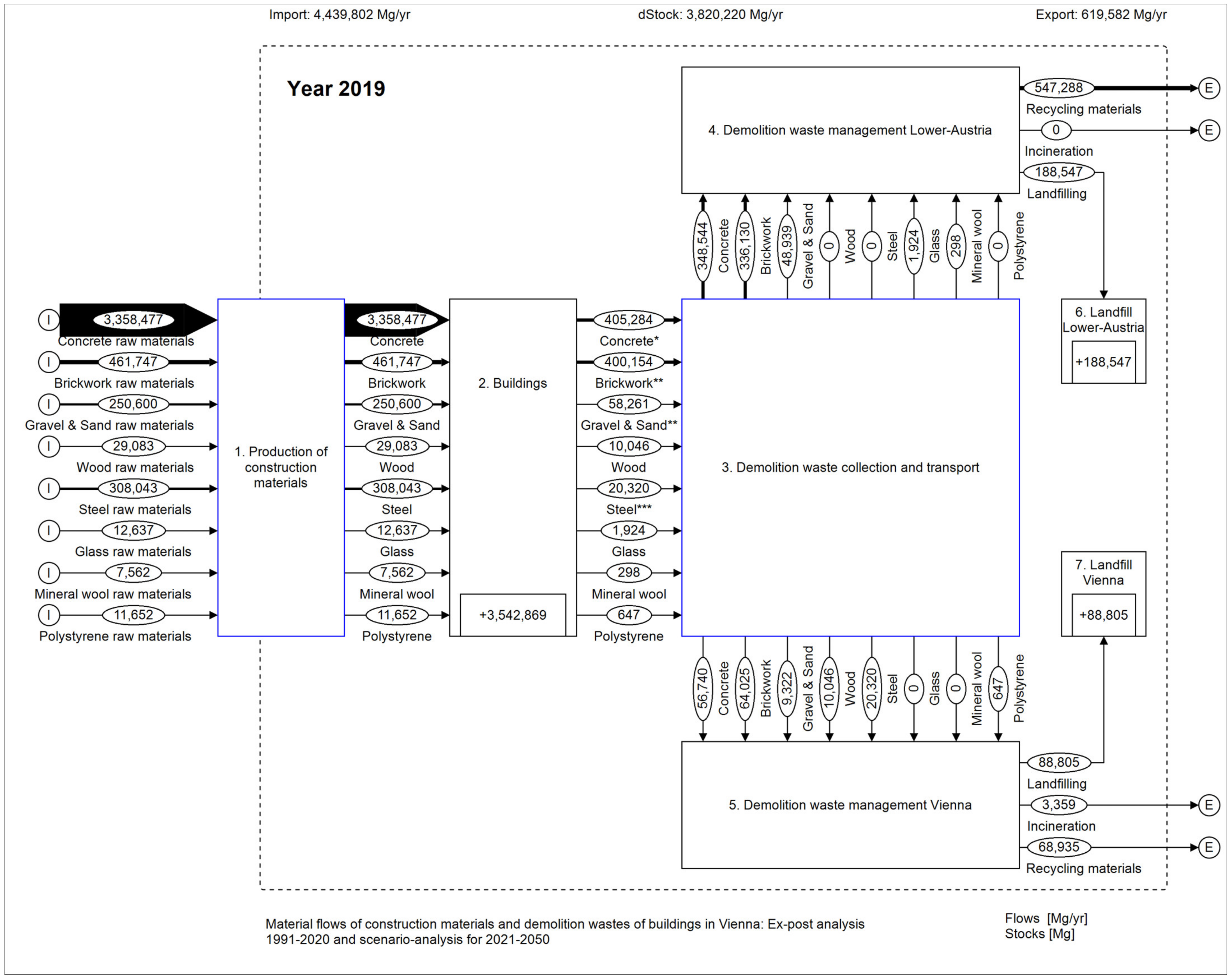
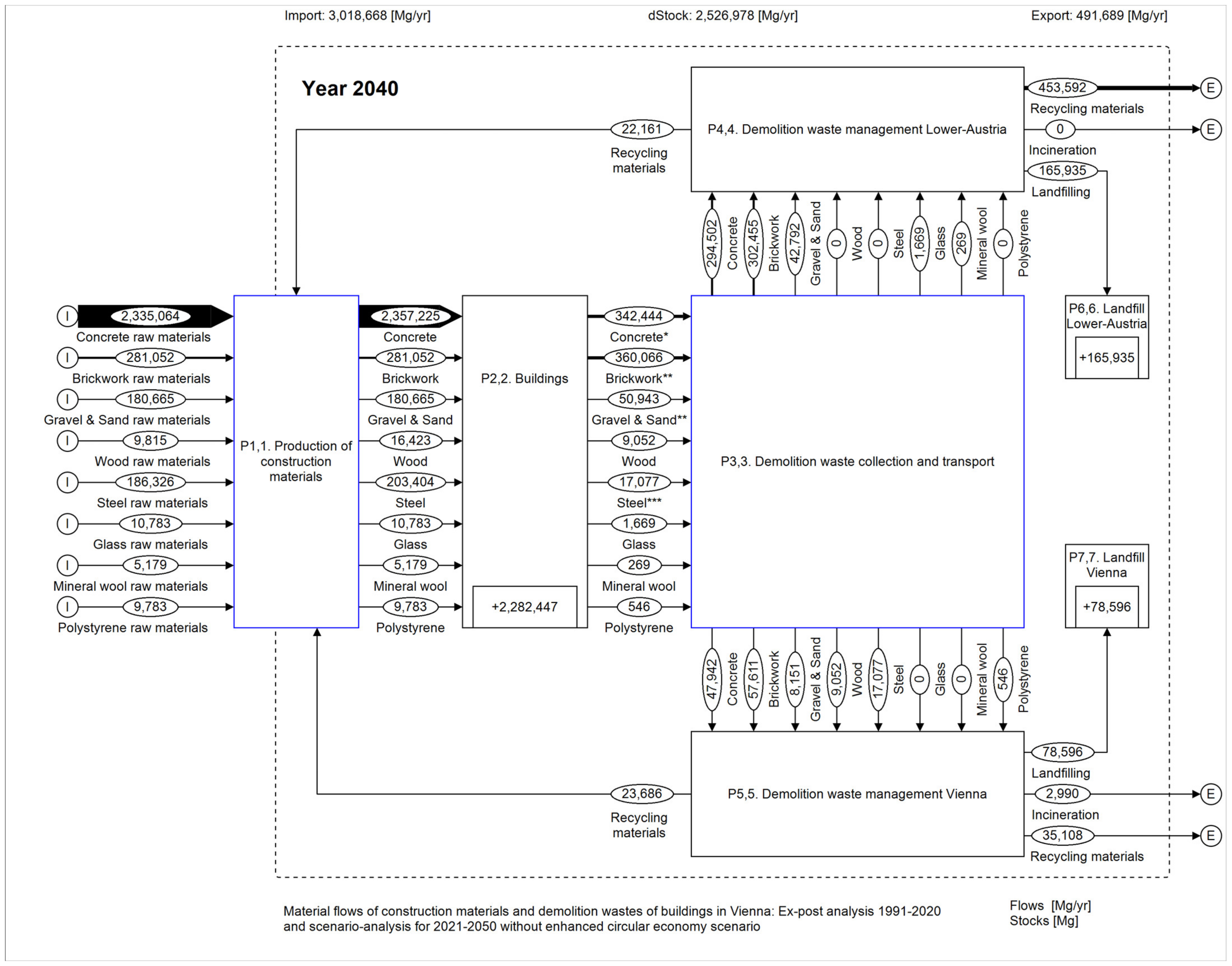



References
- Ritchie, H.; Roser, M. Urbanization. 2018. Available online: https://ourworldindata.org/ (accessed on 27 July 2024).
- Kalmykova, Y.; Rosado, L.; Patrício, J. Resource consumption drivers and pathways to reduction: Economy, policy and lifestyle impact on material flows at the national and urban scale. J. Clean. Prod. 2016, 132, 70–80. [Google Scholar] [CrossRef]
- Schiller, G.; Roscher, J. Impact of urbanization on construction material consumption: A global analysis. J. Ind. Ecol. 2023, 27, 1021–1036. [Google Scholar] [CrossRef]
- Petit-Boix, A.; Leipold, S. Circular economy in cities: Reviewing how environmental research aligns with local practices. J. Clean. Prod. 2018, 195, 1270–1281. [Google Scholar] [CrossRef]
- Prendeville, S.; Cherim, E.; Bocken, N. Circular Cities: Mapping Six Cities in Transition. Environ. Innov. Soc. Transit. 2018, 26, 171–194. [Google Scholar] [CrossRef]
- Marin, J.; Alaerts, L.; Van Acker, K. A Materials Bank for Circular Leuven: How to Monitor ‘Messy’ Circular City Transition Projects. Sustainability 2020, 12, 10351. [Google Scholar] [CrossRef]
- Savini, F. The economy that runs on waste: Accumulation in the circular city. J. Environ. Policy Plan. 2019, 21, 675–691. [Google Scholar] [CrossRef]
- Barles, S. Urban Metabolism of Paris and Its Region. J. Ind. Ecol. 2009, 13, 898–913. [Google Scholar] [CrossRef]
- Chen, S.; Chen, B. Network Environ Perspective for Urban Metabolism and Carbon Emissions: A Case Study of Vienna, Austria. Environ. Sci. Technol. 2012, 46, 4498–4506. [Google Scholar] [CrossRef]
- Christis, M.; Athanassiadis, A.; Vercalsteren, A. Implementation at a city level of circular economy strategies and climate change mitigation—The case of Brussels. J. Clean. Prod. 2019, 218, 511–520. [Google Scholar] [CrossRef]
- Gassner, A.; Lederer, J.; Kanitschar, G.; Ossberger, M.; Fellner, J. Extended ecological footprint for different modes of urban public transport: The case of Vienna, Austria. Land Use Policy 2018, 72, 85–99. [Google Scholar] [CrossRef]
- Rosado, L.; Kalmykova, Y.; Patrício, J. Urban metabolism profiles. An empirical analysis of the material flow characteristics of three metropolitan areas in Sweden. J. Clean. Prod. 2016, 126, 206–217. [Google Scholar] [CrossRef]
- van Oorschot, J.; Sprecher, B.; Rijken, B.; Witteveen, P.; Blok, M.; Schouten, N.; van der Voet, E. Toward a low-carbon and circular building sector: Building strategies and urbanization pathways for the Netherlands. J. Ind. Ecol. 2023, 27, 535–547. [Google Scholar] [CrossRef]
- Lederer, J.; Ott, C.; Brunner, P.H.; Ossberger, M. The life cycle energy demand and greenhouse gas emissions of high-capacity urban transport systems: A case study from Vienna’s subway line U2. Int. J. Sustain. Transp. 2016, 10, 120–130. [Google Scholar] [CrossRef]
- Wurzer, G.; Lorenz, W.; Forster, J.; Bindreiter, S.; Lederer, J.; Gassner, A.; Mitteregger, M.; Kotroczo, E.; Pöllauer, P.; Fellner, J. M-DAB: Towards re-using material resources of the city. In Proceedings of the 38th eCAADe, Anthropologic—Architecture and Fabrication in the Cognitive Age, Berlin, Germany, 17–19 September 2020; pp. 127–132. Available online: http://hdl.handle.net/20.500.12708/65012 (accessed on 28 July 2024).
- Gassner, A.; Lederer, J.; Kovacic, G.; Mollay, U.; Schremmer, C.; Fellner, J. Projection of material flows and stocks in the urban transport sector until 2050–A scenario-based analysis for the city of Vienna. J. Clean. Prod. 2021, 311, 127591. [Google Scholar] [CrossRef]
- Lederer, J.; Gassner, A.; Fellner, J.; Mollay, U.; Schremmer, C. Raw materials consumption and demolition waste generation of the urban building sector 2016–2050: A scenario-based material flow analysis of Vienna. J. Clean. Prod. 2021, 288, 125566. [Google Scholar] [CrossRef]
- Lederer, J.; Gassner, A.; Keringer, F.; Mollay, U.; Schremmer, C.; Fellner, J. Material flows and stocks in the urban building sector: A case study from Vienna for the years 1990–2015. Sustainability 2019, 12, 300. [Google Scholar] [CrossRef]
- Gassner, A.; Lederer, J.; Fellner, J. Material stock development of the transport sector in the city of Vienna. J. Ind. Ecol. 2020, 24, 1364–1378. [Google Scholar] [CrossRef]
- Kleemann, F.; Lederer, J.; Rechberger, H.; Fellner, J. GIS-based Analysis of Vienna’s Material Stock in Buildings. J. Ind. Ecol. 2017, 21, 368–380. [Google Scholar] [CrossRef]
- Cavaleiro de Ferreira, A.; Fuso-Nerini, F. A Framework for Implementing and Tracking Circular Economy in Cities: The Case of Porto. Sustainability 2019, 11, 1813. [Google Scholar] [CrossRef]
- Deistler, J.; Homeier, I.; Lengauer, C.; Pangerl, E.; Rücker, L.; Lutter, J.; Cerveny, M.; Bartik, H.; Hofinger, J.; Veigl, A. Smart Klima City Strategie Wien (Smart Climate City Strategy Vienna); Magistrat der Stadt Wien: Vienna, Austria, 2022; Available online: https://smartcity.wien.gv.at/ (accessed on 27 July 2024).
- Adams, K.T.; Osmani, M.; Thorpe, T.; Thornback, J. Circular economy in construction: Current awareness, challenges and enablers. Proc. Inst. Civ. Eng. Waste Resour. Manag. 2017, 170, 15–24. [Google Scholar] [CrossRef]
- Liedtke, C.; Bienge, K.; Wiesen, K.; Teubler, J.; Greiff, K.; Lettenmeier, M.; Rohn, H. Resource Use in the Production and Consumption System—The MIPS Approach. Resources 2014, 3, 544–574. [Google Scholar] [CrossRef]
- Eisenmenger, N.; Kaufmann, L.; Kalt, G.; Dorninger, C.; Perkovic, M.; Lederer, J.; Fellner, J.; Lutter, S. CO2-und Material-Fußabdruck für Wien (CO2- and Material footprint of Vienna); University of Natural Resources and Life Sciences, Technische Universitaet Wien, Vienna University of Economics and Buisnesses: Vienna, Austria, 2022. [Google Scholar]
- Veigl, A.; Watzak-Helmer, M.; Cerveny, M. Wiens Klima- & Energieziele für 2030 & 2050; Urban Innovation Vienna: Vienna, Austria, 2019. [Google Scholar]
- ENTSO-E. Stromversorgung der Vergangenen 52 Wochen, Stromversorgung in den Vergangenen 30 Tagen Bzw. 12 Monaten. ENTSO-E, Ed. 2024. Available online: https://energie.gv.at/strom/strom (accessed on 27 July 2024).
- BMK. Integrierter nationaler Energie- und Klimaplan für Österreich Periode 2021–2030 (Integrated National Energy and Climate Plan for Austria Period 2021–2030). Draft for Public Consultation; Bundesministerium für Klimaschutz, Umwelt, Energie, Mobilität; Innovation und Technologie (BMK): Vienna, Austria, 2023. [Google Scholar]
- Krutzler, T.; Wasserbaur, R.; Schindler, I. Energie- und Treibhausgasszenarien 2023 (Energy and Greenhouse Gas Scenarios 2023); Umweltbundesamt: Vienna, Austria, 2023. [Google Scholar]
- Lederer, J.; Gassner, A.; Kleemann, F.; Fellner, J. Potentials for a circular economy of mineral construction materials and demolition waste in urban areas: A case study from Vienna. Resour. Conserv. Recycl. 2020, 161, 104942. [Google Scholar] [CrossRef]
- Haas, R.; Siebenhofer, M.; Lederer, J.; Ajanovic, A. Historical Evolution and Scenarios Up to 2050 of Heating Energy Consumption and CO2 Emissions of Residential Buildings in Vienna. J. Energy Power Technol. 2022, 4, 30. [Google Scholar] [CrossRef]
- Stadt_Wien. Nicht gefährlicher Abfall—Abfallmengen in Wien (Non-Hazardous Waste—Waste Quantities in Vienna). Available online: https://www.wien.gv.at/umweltschutz/abfall/nicht-gefaehrliche-abfallmenge.html (accessed on 27 July 2024).
- Statistics_Austria. 2005 bis 2020 Fertiggestellte Wohnungen Nach Gebäudeeigenschaften, Art der Bautätigkeit und Bundesländern (2005 to 2020 Completed Living Units according to Type of Building, Type of Construction Activity and Federal States), 16.11.2021 ed.; Statistics Austria: Vienna, Austria, 2021. [Google Scholar]
- Wohnfonds_Wien. Anzahl der Thermisch Sanierten Wohneinheiten in Wien Nach Bauperiode (Number of Thermal Renovated Living Units after Construction Period); Lederer, J., Ed.; Wien: Vienna, Austria, 2022. [Google Scholar]
- Lederer, J.; Fellner, J.; Gassner, A.; Gruhler, K.; Schiller, G. Determining the material intensities of buildings selected by random sampling: A case study from Vienna. J. Ind. Ecol. 2021, 25, 848–863. [Google Scholar] [CrossRef]
- Müller, A. Energy Demand Assessment for Space Conditioning and Domestic Hot Water: A Case Study for the Austrian Building Stock; Technische Universität Wien: Vienna, Austria, 2015. [Google Scholar]
- OIB. Richtlinien des Österreichischen Instituts für Bautechnik (Standards of the Austrian Institut for Construction Technology). In OIB-Richtlinie 6 Energieeinsparung und Wärmeschutz (OIB Standard 6 Energy Supply and Thermal Insulation); Österreichischen Instituts für Bautechnik (OIB): Vienna, Austria, 2015; Volume OIB-330.6-009/15. [Google Scholar]
- Stadt_Wien. Heating Demand of Restorated Apartments before and after Restoration, 08.10.2021 ed.; Magistrat Wien—Magistratsabteilung 20—Energieplanung: Vienna, Austria, 2021. [Google Scholar]
- Bayer, G.; Sturm, T.; Steininger, M. Energieflüsse in Bürogebäuden; Österreichische Gesellschaft für Umwelt und Technik (ÖGUT): Wien, Austria, 2014. [Google Scholar]
- Umweltbundesamt. Berechnung von Treibhausgas (THG)-Emissionen Verschiedener Energieträger. Available online: https://secure.umweltbundesamt.at/co2mon/co2mon.html (accessed on 27 July 2024).
- Brunner, P.H.; Rechberger, H. Handbook of Material Flow Analysis: For Environmental, Resource, and Waste Engineers, 2nd ed.; CRC Press: Boca Raton, FL, USA, 2016. [Google Scholar]
- Land_Niederösterreich. NIederösterreichischer Abfallwirtschaftsplan (Waste Management Plan of Lower-Austria); Land Niederösterreich, Gruppe Raumordnung, Umwelt und Verkehr (Federal State of Lowwer-Austria, Group Spatial Planning, Environment and Transport): St. Pölten, Austria, 2018. [Google Scholar]
- Bernhardt, A.; Kleemann, F.; Neubauer, C.; Neubauer, M.; Walter, B. Datenanalyse zur Behandlung von Mineralischen Bau- und Abbruchabfällen in Österreich—Detailstudie zum Bundes-Abfallwirtschaftsplan (Data Analysis on the Treatment of Mineral Construction and Demolition Wastes in Austria—Detailed Study for the Federal Waste Management Plan); Umweltbundesamt (Federal Environment Agency): Vienna, Austria, 2019. [Google Scholar]
- ContraCon. Amounts and Types of Demolition Waste Treated and Recycling Materials Produced; Lederer, J., Ed.; ContraCon: Vienna, Austria, 2023; Available online: https://www.contracon.at/ (accessed on 27 July 2024).
- LangesFeld. Amounts and Types of Demolition Waste Treated and Recycling Materials Produced; Lederer, J., Ed.; LangesFeld: Vienna, Austria, 2023; Available online: https://langesfeld.at/ (accessed on 27 July 2024).
- Mauschitz, G. Emissionen aus Anlagen der Österreichischen Zementindustrie—Berichtsjahr 2016 (Emissions from Plants of the Austrian Cement Industry—Reporting Year 2016); TU Wien: Vienna, Austria, 2017. [Google Scholar]
- BMK. Bundes-Abfallwirtschaftsplan (BAWP) 2023 Teil 1 (Federal Waste Management Plan 2023 Part 1); Bundesministerin für Klimaschutz, Umwelt, Energie, Mobilität, Innovation und Technologie (BMK): Vienna, Austria, 2023. [Google Scholar]
- Zeitlhofer, H.; Peyerl, M.; Krispel, S. Evaluierung des Einsatzes Alternativer Rohstoffe in der Klinkerproduktion zur Minderung der Treibhausgasemissionen (Evaluation of the Use of Alternative Raw Materials in the Clinker Production for the Reduction of Greenhouse Gas Emissions); Smart Minerals: Vienna, Austria, 2018; p. 61. [Google Scholar]
- Mostert, C.; Bringezu, S. Measuring Product Material Footprint as New Life Cycle Impact Assessment Method: Indicators and Abiotic Characterization Factors. Resources 2019, 8, 61. [Google Scholar] [CrossRef]
- Watari, T.; McLellan, B.C.; Giurco, D.; Dominish, E.; Yamasue, E.; Nansai, K. Total material requirement for the global energy transition to 2050: A focus on transport and electricity. Resour. Conserv. Recycl. 2019, 148, 91–103. [Google Scholar] [CrossRef]
- Oliveira Neto, G.C.; Correia, J.M. Environmental and economic advantages of adopting reverse logistics for recycling construction and demolition waste: A case study of Brazilian construction and recycling companies. Waste Manag. Res. 2019, 37, 176–185. [Google Scholar] [CrossRef] [PubMed]
- Wuppertal_Institute. Material Intensity of Materials, Fuels, Transport Services, Food; Wuppertal Institute for Climate, Environment and Energy GmbH: Wuppertal, Germany, 2014. [Google Scholar]
- BMK. Die österreichische Kreislaufwirtschaft. Österreich auf dem Weg zu Einer Nachhaltigen und Zirkulären Gesellschaft; Bundesministerium für Klimaschutz, Umwelt, Energie, Mobilität, Innovation und Technologie (BMK): Vienna, Austria, 2021. [Google Scholar]
- Moraga, G.; Huysveld, S.; Mathieux, F.; Blengini, G.A.; Alaerts, L.; Van Acker, K.; de Meester, S.; Dewulf, J. Circular economy indicators: What do they measure? Resour. Conserv. Recycl. 2019, 146, 452–461. [Google Scholar] [CrossRef]
- Heeren, N.; Hellweg, S. Tracking Construction Material over Space and Time: Prospective and Geo-referenced Modeling of Building Stocks and Construction Material Flows. J. Ind. Ecol. 2019, 23, 253–267. [Google Scholar] [CrossRef]
- Soonsawad, N.; Marcos-Martinez, R.; Schandl, H. City-scale assessment of the material and environmental footprint of buildings using an advanced building information model: A case study from Canberra, Australia. J. Ind. Ecol. 2024, 28, 247–261. [Google Scholar] [CrossRef]
- Gollner, M. Nutzenergieanalyse. Available online: https://www.statistik.at/statistiken/energie-und-umwelt/energie/nutzenergieanalyse (accessed on 22 April 2022).
- Jylhä, K.; Jokisalo, J.; Ruosteenoja, K.; Pilli-Sihvola, K.; Kalamees, T.; Seitola, T.; Mäkelä, H.M.; Hyvönen, R.; Laapas, M.; Drebs, A. Energy demand for the heating and cooling of residential houses in Finland in a changing climate. Energy Build. 2015, 99, 104–116. [Google Scholar] [CrossRef]
- Eyre, N.; Baruah, P. Uncertainties in future energy demand in UK residential heating. Energy Policy 2015, 87, 641–653. [Google Scholar] [CrossRef]
- Harris, S.; Weinzettel, J.; Bigano, A.; Källmén, A. Low carbon cities in 2050? GHG emissions of European cities using production-based and consumption-based emission accounting methods. J. Clean. Prod. 2020, 248, 119206. [Google Scholar] [CrossRef]
- Zhang, C.; Hu, M.; Sprecher, B.; Yang, X.; Zhong, X.; Li, C.; Tukker, A. Recycling potential in building energy renovation: A prospective study of the Dutch residential building stock up to 2050. J. Clean. Prod. 2021, 301, 126835. [Google Scholar] [CrossRef]
- Hoxha, E.; Röck, M.; Truger, B.; Steininger, K.; Passer, A. Austrian GHG emission targets for new buildings and major renovations: An exploratory study. IOP Conf. Ser. Earth Environ. Sci. 2020, 588, 032052. [Google Scholar] [CrossRef]
- Perissi, I.; Jones, A. Investigating European Union Decarbonization Strategies: Evaluating the Pathway to Carbon Neutrality by 2050. Sustainability 2022, 14, 4728. [Google Scholar] [CrossRef]
- Zhang, C.; Hu, M.; van der Meide, M.; Di Maio, F.; Yang, X.; Gao, X.; Li, K.; Zhao, H.; Li, C. Life cycle assessment of material footprint in recycling: A case of concrete recycling. Waste Manag. 2023, 155, 311–319. [Google Scholar] [CrossRef]

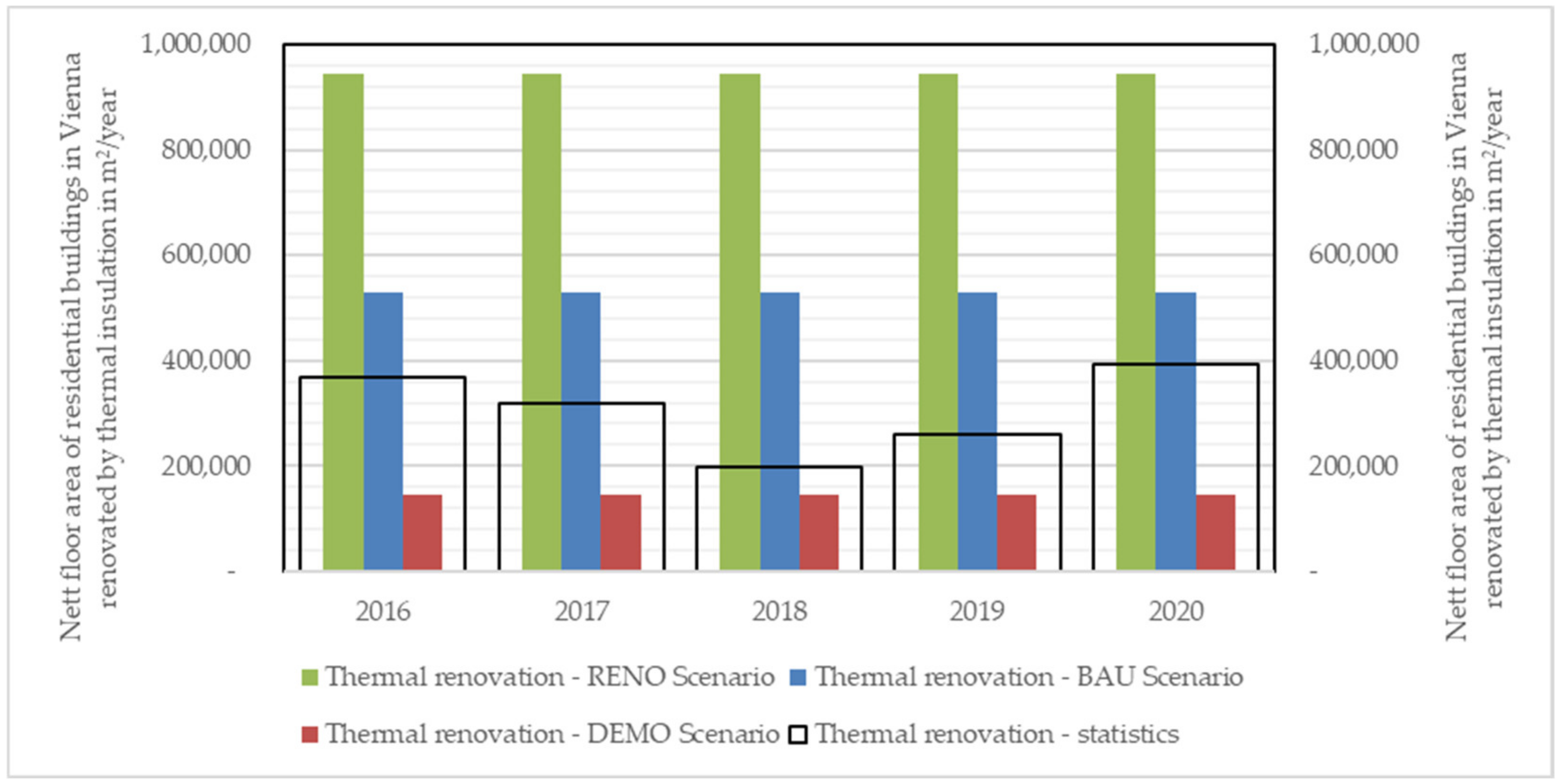

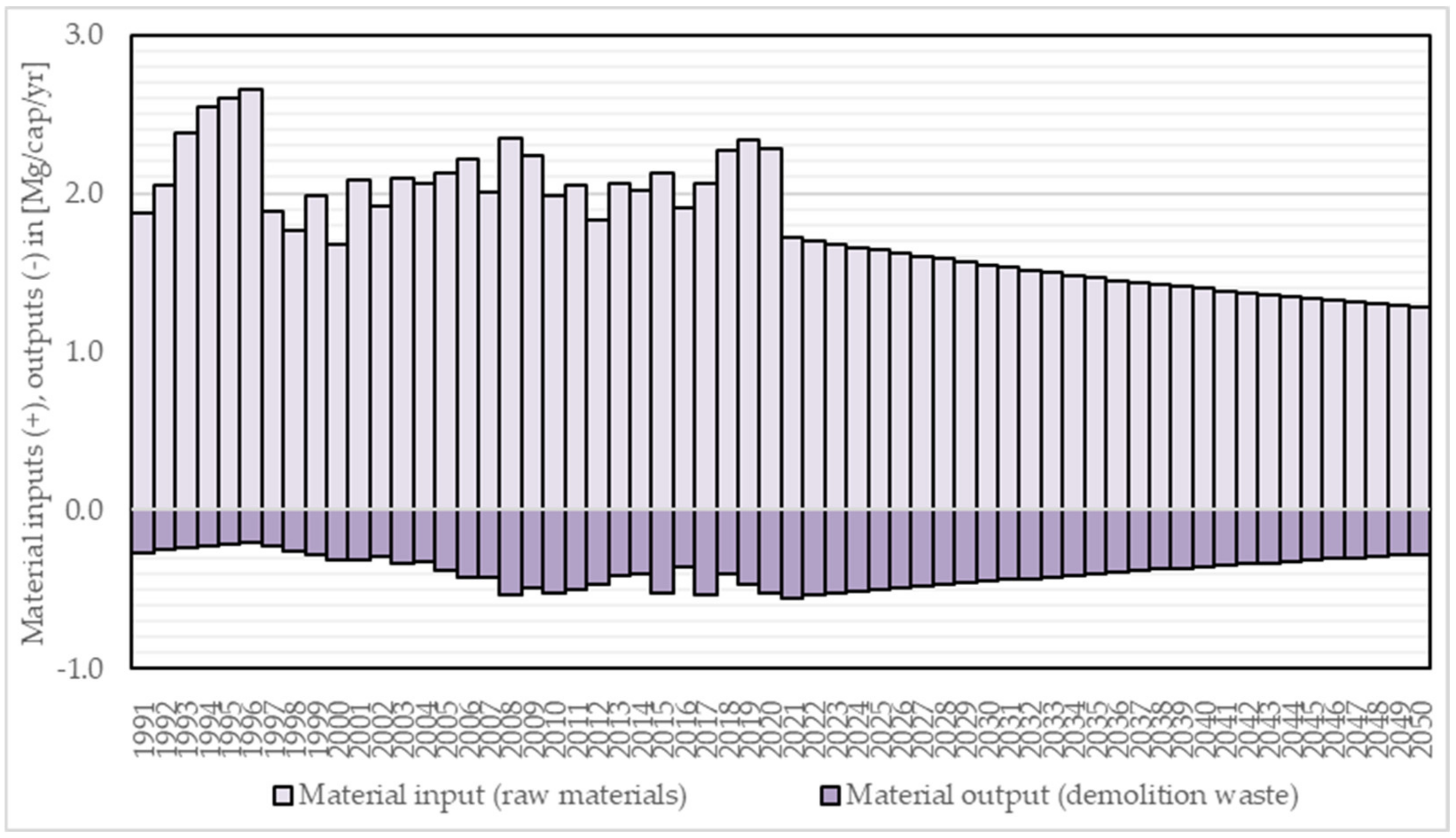
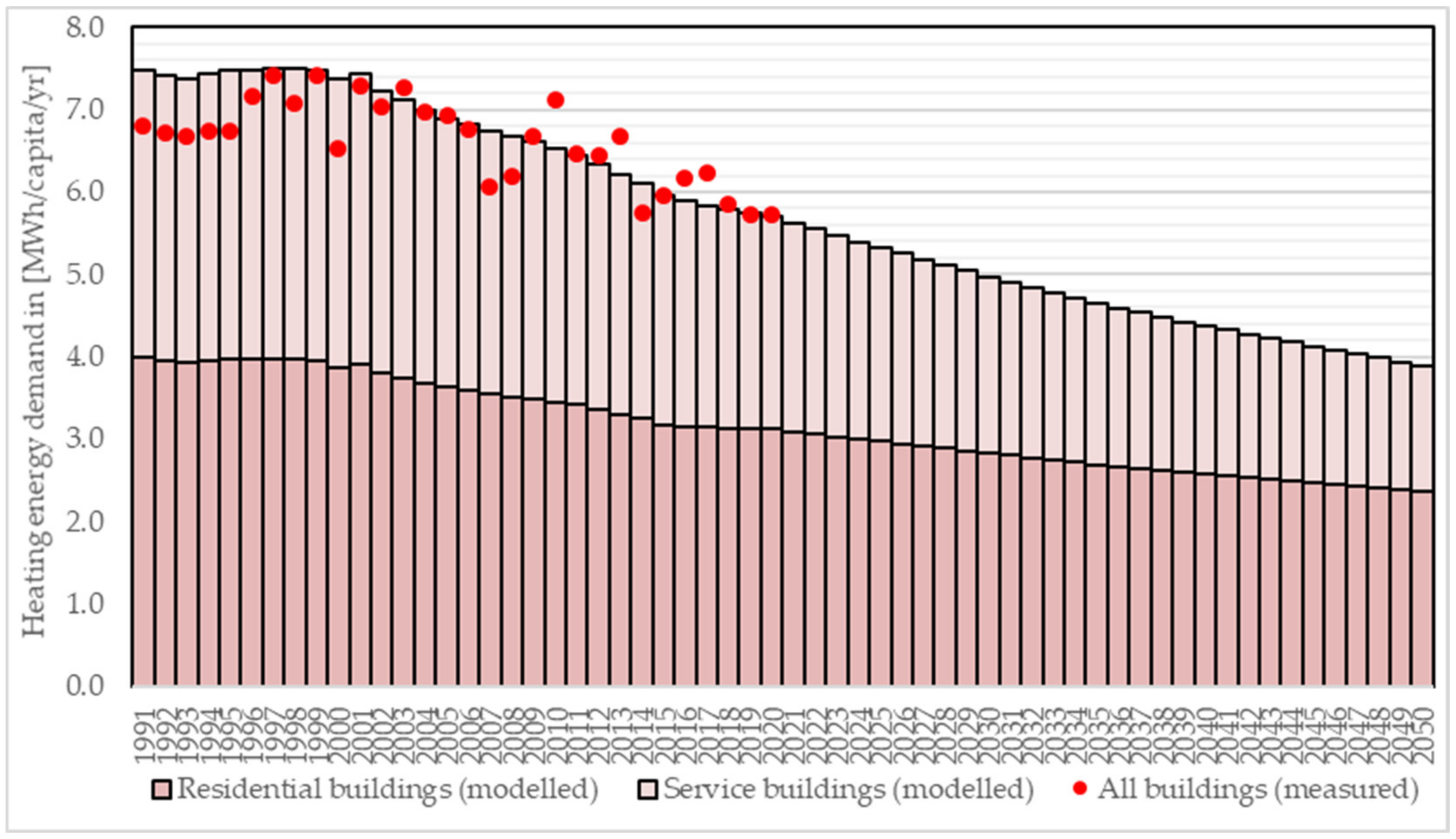
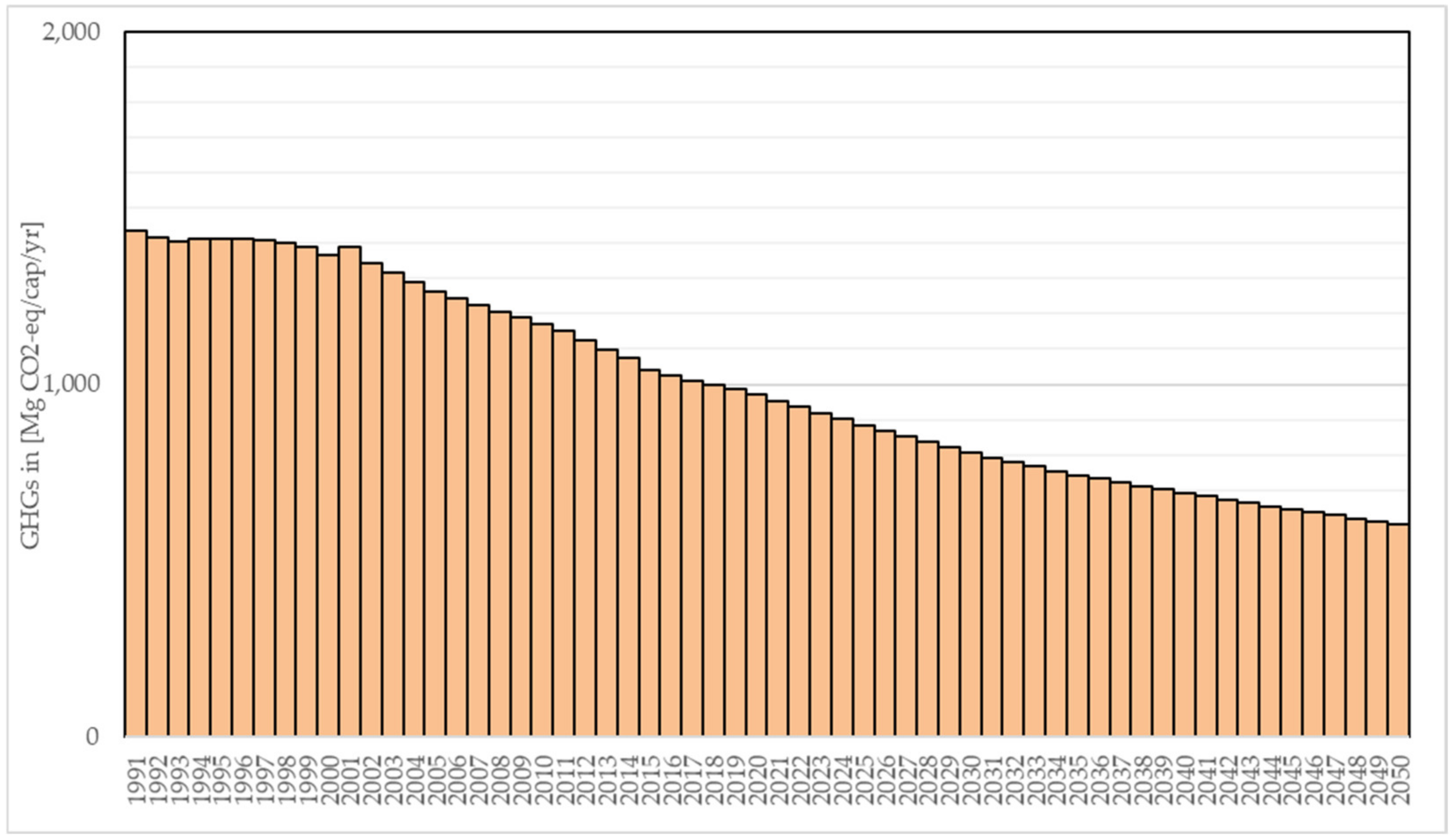


| Year | 2016 | 2017 | 2018 | 2019 | 2020 | 2021 (1) | 2030 (2) | 2040 (2) | 2050 (3) |
|---|---|---|---|---|---|---|---|---|---|
| Updated Data from Statistic | Modelled Data Updated | ||||||||
| Population (capita) | 1,855,254 | 1,870,282 | 1,885,310 | 1,900,338 | 1,915,366 | 1,930,394 | 2,065,647 | 2,195,061 | 2,286,094 |
| New construction of residential, service, industrial, and other buildings (4) | |||||||||
| Residential | 544,960 | 656,256 | 808,960 | 851,712 | 897,088 | 523,841 | 506,241 | 486,685 | 467,130 |
| Service | 375,271 | 375,271 | 375,271 | 375,271 | 375,271 | 428,612 | 412,075 | 393,700 | 375,325 |
| Industrial | 70,630 | 70,630 | 70,630 | 70,630 | 70,630 | 211,176 | 192,196 | 171,106 | 150,016 |
| Other | 444,714 | 444,714 | 444,714 | 444,714 | 444,714 | 250,752 | 248,323 | 245,623 | 242,924 |
| New attic extension on existing buildings (only applicable to residential buildings) (4) | |||||||||
| Residential | 294,600 | 343,700 | 392,800 | 441,900 | 294,600 | 176,405 | 176,405 | 176,405 | 176,405 |
| 1800–1918 | 235,680 | 274,960 | 314,240 | 353,520 | 235,680 | 124,656 | 124,656 | 124,656 | 124,656 |
| 1919–1945 | 58,920 | 68,740 | 78,560 | 88,380 | 58,920 | 51,749 | 51,749 | 51,749 | 51,749 |
| New thermal insulation on existing buildings (only applicable to residential and service buildings) (4) | |||||||||
| Residential | 369,475 | 317,867 | 197,476 | 260,073 | 392,999 | 174,847 | 305,541 | 450,756 | 595,970 |
| 1800–1918 | 66,504 | 56,736 | 33,211 | 50,875 | 38,095 | 33,211 | 74,597 | 120,581 | 166,565 |
| 1919–1945 | 93,773 | 53,968 | 37,932 | 44,933 | 177,533 | 15,303 | 38,729 | 64,757 | 90,785 |
| 1946–1980 | 209,198 | 207,163 | 126,333 | 164,265 | 177,371 | 126,333 | 192,215 | 265,418 | 338,620 |
| Service | 137,159 | 136,640 | 135,856 | 135,260 | 134,563 | 134,563 | 137,054 | 139,823 | 142,592 |
| 1800–1918 | 85,655 | 85,489 | 85,238 | 85,047 | 84,824 | 84,824 | 85,681 | 86,634 | 87,587 |
| 1919–1945 | 8194 | 8150 | 8084 | 8033 | 7974 | 7974 | 8192 | 8434 | 8676 |
| 1946–1980 | 43,310 | 43,001 | 42,534 | 42,180 | 41,765 | 41,765 | 43,181 | 44,755 | 46,329 |
| Demolition of existing buildings (4) | |||||||||
| Residential | 113,478 | 171,523 | 130,311 | 152,511 | 148,199 | 175,731 | 158,132 | 138,576 | 119,022 |
| 1800–1918 | 79,809 | 120,632 | 91,648 | 107,261 | 93,610 | 120,632 | 108,907 | 95,880 | 82,853 |
| 1919–1945 | 27,236 | 41,168 | 31,276 | 36,605 | 44,160 | 44,160 | 39,357 | 34,019 | 28,682 |
| 1946–1980 | 5521 | 8345 | 6340 | 7420 | 8951 | 8951 | 7978 | 6896 | 5814 |
| 1981–2000 | 912 | 1378 | 1047 | 1225 | 1478 | 1478 | 1380 | 1271 | 1163 |
| 2001–2020 | - | - | - | - | - | 510 | 510 | 510 | 510 |
| Service | 98,644 | 149,101 | 113,277 | 132,576 | 159,941 | 160,451 | 137,054 | 111,058 | 85,060 |
| 1800–1918 | 16,624 | 25,127 | 19,090 | 22,342 | 26,953 | 26,953 | 23,925 | 20,560 | 17,195 |
| 1919–1945 | 4400 | 6651 | 5053 | 5914 | 7135 | 7135 | 6243 | 5253 | 4262 |
| 1946–1980 | 30,876 | 46,669 | 35,456 | 41,497 | 50,062 | 50,062 | 42,678 | 34,473 | 26,267 |
| 1981–2000 | 46,744 | 70,654 | 53,678 | 62,823 | 75,791 | 75,791 | 63,856 | 50,596 | 37,336 |
| 2001–2020 | - | - | - | - | - | 510 | 352 | 176 | - |
| Industrial | 82,400 | 124,547 | 94,623 | 110,742 | 133,602 | 133,602 | 114,621 | 93,531 | 72,441 |
| 1800–1918 | 10,287 | 15,549 | 11,813 | 13,825 | 16,679 | 16,679 | 14,726 | 12,556 | 10,385 |
| 1919–1945 | 9447 | 14,278 | 10,848 | 12,696 | 15,317 | 15,317 | 13,410 | 11,291 | 9173 |
| 1946–1980 | 40,725 | 61,556 | 46,766 | 54,733 | 66,031 | 66,031 | 56,413 | 45,727 | 35,040 |
| 1981–2000 | 21,941 | 33,164 | 25,196 | 29,488 | 35,575 | 35,575 | 30,072 | 23,957 | 17,843 |
| 2001–2020 | - | - | - | - | - | - | - | - | - |
| Building Type | 1800–1918 | 1919–1945 | 1946–1980 | 1981–2000 | 2001–2020 | 2021–2050 |
|---|---|---|---|---|---|---|
| Conversion factor CFGFA/NFA [-] (1) | ||||||
| Residential | 0.76 | 0.81 | 0.83 | 0.81 | 0.80 | 0.80 |
| Service | 0.75 | 0.77 | 0.90 | 0.95 | 0.95 | 0.95 |
| Heating energy demand [kwh/m² GFA] | ||||||
| Residential | ||||||
| Existing buildings | 100 (2) | 90 (2) | 80 (2) | 50 (2) | 45 (3) | 22 (4) |
| Thermal insulation | 38 (5) | 38 (5) | 38 (5) | |||
| Attic extension | 38 (5) | 38 (5) | ||||
| Service | ||||||
| Existing buildings | 250 (6) | 250 (6) | 250 (6) | 130 (6) | 70 (6) | 22 (6) |
| Thermal insulation | 80 (6) | 80 (6) | 80 (6) | |||
| Heating energy demand [kwh/m² NFA] | ||||||
| Residential | ||||||
| Existing buildings | 132 | 111 | 96 | 62 | 56 | 28 |
| Thermal insulation | 50 | 47 | 46 | |||
| Attic extension | 50 | 47 | ||||
| Service | ||||||
| Existing buildings | 333 | 325 | 272 | 144 | 74 | 23 |
| Thermal insulation | 107 | 104 | 87 | |||
| Indicator | Value | Unit | 2005 | 2030 | 2040 | 2050 |
|---|---|---|---|---|---|---|
| HED | Modelled value | kwh/cap/yr | 6620 | 4972 | 4372 | 3892 |
| Value that has to be achieved | 5296 | 4634 | ||||
| Modelled value | % of the average 2005–2010 | 100% | 75% | 66% | 59% | |
| Value that has to be achieved | 100% | 80% | 70% | |||
| GHG | Modelled value | kg CO2-eq./cap/yr | 1217 | 805 | 692 | 602 |
| Value that has to be achieved | 548 | 0 | 0 | |||
| Modelled value | % of the average 2005–2010 | 100% | 66% | 57% | 49% | |
| Value that has to be achieved | 100% | 45% | 0% | 0% |
| Indicator | Value | Unit | 2019 | 2030 | 2040 | 2050 |
|---|---|---|---|---|---|---|
| TMR | Modelled value for primary raw materials | kg/cap/yr | 3929 | 2568 | 2318 | 2132 |
| Modelled value for reduction by local recycling | −37 | −681 | −550 | −426 | ||
| Modelled value total | 3892 | 1887 | 1769 | 1705 | ||
| Value that has to be achieved | 3892 | 2725 | 2335 | 1946 | ||
| Modelled value total | % of the year 2019 | 100% | 48% | 45% | 44% | |
| Value that has to be achieved | 100% | 70% | 60% | 50% | ||
| CMUR | Modelled value | % of material input | 1% | 28% | 25% | 21% |
| Value that has to be achieved | 12% (1) | 18% (2) | 18% (2) | 18% (3) |
Disclaimer/Publisher’s Note: The statements, opinions and data contained in all publications are solely those of the individual author(s) and contributor(s) and not of MDPI and/or the editor(s). MDPI and/or the editor(s) disclaim responsibility for any injury to people or property resulting from any ideas, methods, instructions or products referred to in the content. |
© 2024 by the authors. Licensee MDPI, Basel, Switzerland. This article is an open access article distributed under the terms and conditions of the Creative Commons Attribution (CC BY) license (https://creativecommons.org/licenses/by/4.0/).
Share and Cite
Lederer, J.; Blasenbauer, D. Material Flow Analysis-Based Sustainability Assessment for Circular Economy Scenarios of Urban Building Stock of Vienna. Sustainability 2024, 16, 7319. https://doi.org/10.3390/su16177319
Lederer J, Blasenbauer D. Material Flow Analysis-Based Sustainability Assessment for Circular Economy Scenarios of Urban Building Stock of Vienna. Sustainability. 2024; 16(17):7319. https://doi.org/10.3390/su16177319
Chicago/Turabian StyleLederer, Jakob, and Dominik Blasenbauer. 2024. "Material Flow Analysis-Based Sustainability Assessment for Circular Economy Scenarios of Urban Building Stock of Vienna" Sustainability 16, no. 17: 7319. https://doi.org/10.3390/su16177319
APA StyleLederer, J., & Blasenbauer, D. (2024). Material Flow Analysis-Based Sustainability Assessment for Circular Economy Scenarios of Urban Building Stock of Vienna. Sustainability, 16(17), 7319. https://doi.org/10.3390/su16177319






